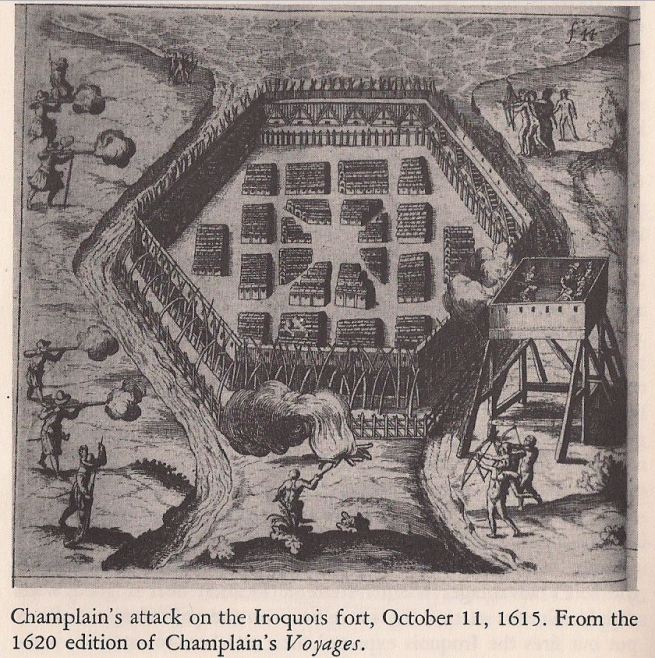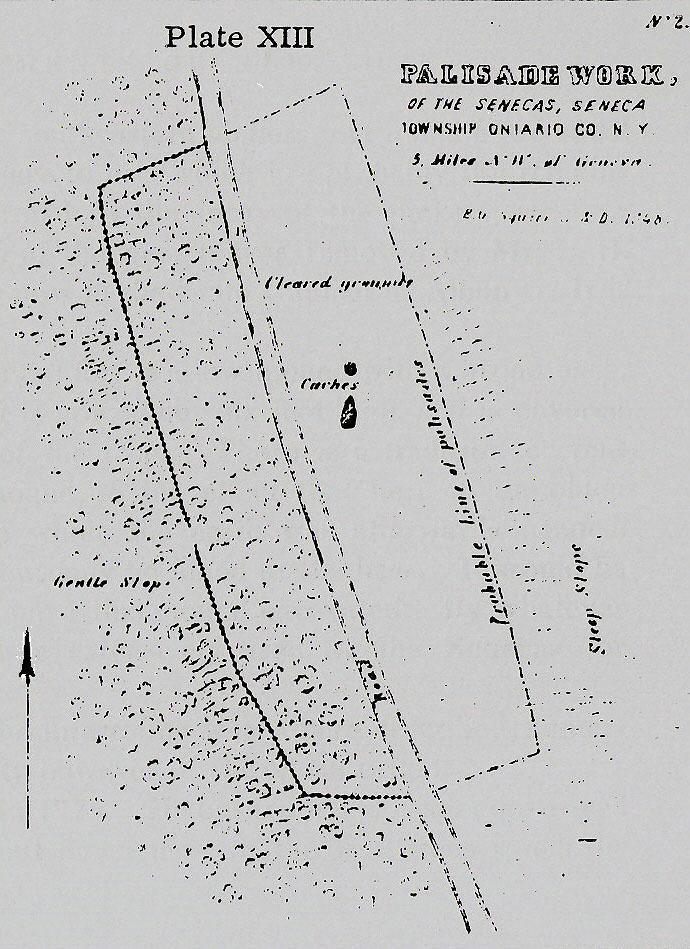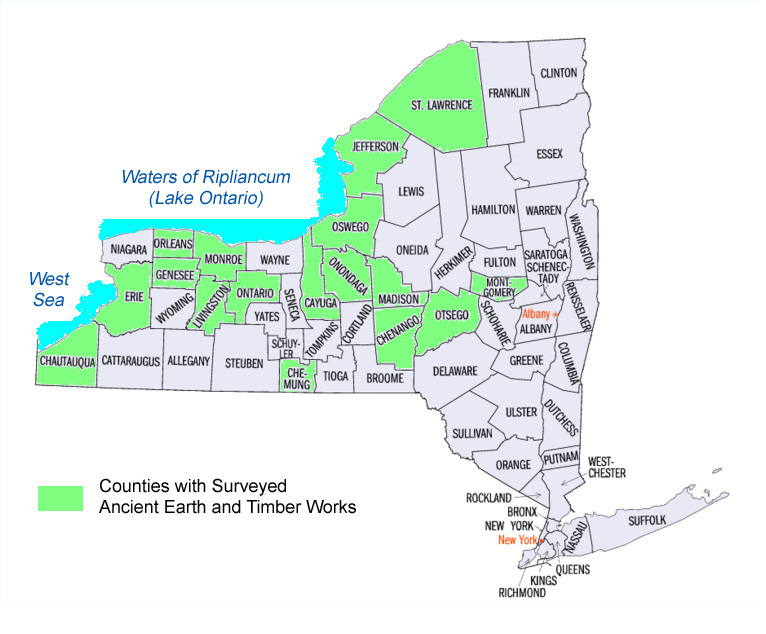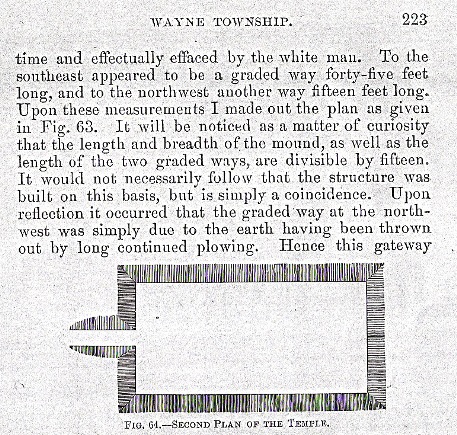"Blinded
by the gold of the pharaohs and the mighty ruins of
Babylon, Book of Mormon students have declared themselves "not interested"
in the drab and commonplace remains of our lowly Indians. But in all the Book
of Mormon we look in vain for anything that promises majestic ruins."
(Hugh
Nibley, An Approach to the Book of
Mormon (Melchizedek Priesthood manual, 1957), appendix section titled
"Looking for the Wrong Things", pp. 440-441)

Depicted
above:
An unsuccessful attack conducted by Champlain and allied Huron braves on an
Iroquois palisade fortification in
New York. Champlain retreated and
became lost for a while in the “southern Ontario lake country” of New York.
(Champlain
and the French in New York, University of the State of New York, State
Education Department, Albany 1959, pp. 24-25; researched by Phyllis Carol
Olive)
The
ravages of nature, scavenging and demolition have taken a heavy toll on
archaeological sites in western New York
. A comment made by Nephi and Isaiah applies:
"...the
multitude of their terrible ones shall be as chaff that passeth away..." (2
Nephi 26:19, Isaiah 29:5)
In
the appendix of An Approach to the Book
of Mormon (under the section titled "Vanished Worlds");
Professor Hugh Nibley discourses on the loss of monuments of the past
and of antiques:
"Northern
Germany
was rich in
megalithic monuments at the beginning of the nineteenth century, but now they
have vanished. In every civilized country societies were founded in the
nineteenth century to stem the tide of destruction that swept away monuments
of the past with the increase of population, the opening of new lands to
cultivation by new methods, the ceaseless depredations of treasure and
souvenir hunters. But the antiquities went right on disappearing.
[Carl
Schuchardt, Alteuropa (Berlin: De
Grunter, 1935)]
"
"The
same thing happened in
America
. We too easily forget what a wealth of imposing ruins of the Heroic type once
dotted the eastern part of the country. "Not content with having almost
entirely exterminated the natives of this continent," an observer wrote
at the beginning of this century, "unsatisfied with the tremendous fact
that we have violated covenant engagements and treaty pledges with the Indians
a hundred times over, we seem to be intent on erasing the last vestige of
aboriginal occupation of our land." [Warren K. Morehead,
Fort
Ancient
(Cincinnati: Clark, 1890), pg. 107] This was written in an appeal to save some
of the great mounds of Ohio: "There are a number of structures of earth
and stone scattered throughout our state...All such earthworks are, of course,
placed on summits of high hills, or on plateaus overlooking river valleys."
At
fort
Miami
, "it seems as if blockhouses or bastions of wood had been burned down
when once protecting the gateway." [Ibid, pp
102-103]
This is not only an excellent description of Book of Mormon strong
places, but it also suits exactly the picture of the standard fortified places
of the
Old World
. Hundreds of such hill forts have been located all over Europe and the
British Isles
, where they seem to represent the normal life of the people over, long
periods of time." (An
Approach to the B. of M, pp 438-439)
Professor
Hugh Nibley
summarizes the archaeological problem:
"...Book
of Mormon archaeologists have often been disappointed in the past because they
have consistently looked for the wrong things. We should not be surprised at
the lack of ruins in
America
in general. Actually the scarcity of identifiable remains in the
Old World
is even more impressive. In view of the nature of their civilization one
should not be puzzled if the Nephites had left us no ruins at all. People
underestimate the capacity of things to disappear, and do not realize that the
ancients almost never built of stone. Many a great civilization which has left
a notable mark in history and literature has left behind not a single
recognizable trace of itself. We must stop looking for the wrong things."
(An Approach to the B of M,
pg. 431)

Site of an
ancient breastwork of timber surveyed by E. G. Squier in Ontario County, New
York
"...small
forts, or places or resort..."
(Alma 48:8)
The Bible
lacks archaeological support for many of its claims. This has not prevented
Bible maps from featuring, for instance, "the traditional route of
the Exodus",
or "Mt. Sinai".
These are not generally agreed upon by religious and secular
authorities.
The northern
American setting of the Book of Mormon, deserves to be mapped. Book of Mormon maps should
be based chiefly on scripture. LDS scripture and the
statements of Joseph Smith, show that at least some lands of the Book of
Mormon are in the neighborhood of Lake Erie, Lake Ontario and the Finger
Lakes (Cumorah in its
land of many waters).
The emphasis placed here on LDS scripture and verifiable statements of
Joseph Smith should not be taken to mean that archaeological correlations
have not been found in the region of
the Finger Lakes.
"The museums
in
New York
State
are filled with the instruments of warfare that had been fashioned by the red
men and so freely used in that historic era. The opinion is expressed in those
relic halls that western
New York
was the site of an ancient battlefield. There is more evidence of a well
planned defensive warfare in that locality than there is in any other region
on the American continent." (I.
H. Smith, History of Duchess County, pg. 13)
Prior
to their demolition, the remains of numerous earth and timber fortresses could
be found throughout the counties of
New York
State. Ephraim George Squier, commissioned by the Smithsonian Institution,
documented this fact.
In 1848, E. G.
Squier devoted eight weeks to searching out these remains. He had no exact
means of dating the various earth and timber works which he surveyed. He
erroneously proposed that the irregular shape of the earth-works (compared to
more geometric earth-works of the Mississippi Valley) suggested that the
New York earth-works were of "the period succeeding the commencement of European
intercourse." (ABORIGINAL MONUMENTS OF THE STATE OF NEW YORK,
by E.G. Squier, pg. 10)
But upon concluding
his report Squier states:
"By whom were
the aboriginal monuments of
Western New York
erected, and to what era may they be ascribed? The consideration of these
questions has given rise to a vast amount of speculation... If the results
arrived at have been erroneous, unsatisfactory, or extravagant, it may be
ascribed to the circumstance that the facts heretofore collected have been too
few in number and too poorly authenticated to admit of correct conclusions..."
"In respect to
date nothing positive can be affirmed. Many of them [old fortified towns and
citadels] are now covered with forests... I have seen trees from one to three
feet in diameter standing upon the embankments and in the trenches; which
would certainly carry back the date of their construction several hundred
years, perhaps beyond the period of the discovery in the fifteenth century..."
(A.
M. of the S. of N. Y., pp. 81-82)
Certainly
some of the fortifications Squier visited were constructed in more recent
centuries. Evidently native peoples of
New York
continued to build earth and timber fortresses long after Book of Mormon
times. Their entrenchments, banks of earth and timber palisades are a far
better match for the constructions described in the Book of Mormon than any
of the stupendous stone buildings found in Central and South America.
Contrasting the works of the mound builders with
Mesoamerica stone ruins, Hugh Nibley observes: “A closer approximation to
the Book of Mormon picture of Nephite culture is seen in the earth and
palisade structures of the Hopewell
and Adena culture areas than in the later stately piles of stone in
Mesoamerica…
Though such piles as the great pyramid-temple of Chichen Itza
are surpassed by few buildings in the world in beauty of proportion and
grandeur of conception, there is something disturbing about most of these
overpowering ruins… The great monuments do not represent what the Nephites
stood for; rather they stand for what their descendents, mixed with the
blood of their brethren, descended to…” (Hugh Nibley, The Prophetic Book
of Mormon, pp. 272-273)
The great
Chichen Itza
temple-pyramid of Kukulcan
features in the background of the popular LDS painting "Christ in America", and the
"The TESTAMENTS". The scene may be interpreted to depict a visit by
Kukulcan to the people of the Yucatan in the 11th century AD or later, but a
scene from the Book of Mormon, it most certainly is not.
Squier
points out that the ancient stockades of Western New York are not unlike
structures made by natives of Australia, the British Islands, Mexico, Peru,
the Pacific Islands, and the Steppes of Russia. The general nature of such
defenses is not unique to any one culture.
(Ezekiel 17:17)
Opposed to the
theory that the
"Mound-builders" were an advanced race not related to "the
Indians", Squier contends that the ancient fortresses of
Western New York
were constructed entirely by ancestors of indigenous people. The Book of
Mormon does not disagree. Squier, however, seems incredulous towards the idea
that natives of
New York
might have some connection to peoples of the Middle East. Squier is willing to concede that some of the earth-works could be very old,
as long as no credence is given to the idea of a lost race:
"...if the
earth-works of
Western New York
are of remote ancient date, they were not only secondarily
but generally occupied by the
Iroquois or neighboring and contemporary nations..." Squier
remarks.
(A.
M. of the S. of N. Y., pg. 82)
According to
Squier, nearly all of the earth and timber works served as defenses:
"...Their
positions, general close proximity to water, and other circumstances no less
conclusive, imply a defensive origin. The unequivocal traces of long
occupation found within many of them, would further imply that they were
fortified towns and villages, and were permanently occupied. Some of the
smaller ones, on the other hand, seem rather designed for temporary
protection, - the citadels in which the builders sought safety for their old
men, women, and children in case of alarm or attack."
(A.
M. of the S. of N. Y., pp. 81)
As for the number
of ancient works in New York State, Squier informs us that:
"In the short
period of eight weeks devoted to the search, I was enabled to ascertain the
localities of no less than one hundred ancient works,
[including works in Seneca,
Wayne, Niagara and
Wyoming
counties, pg 11] and to visit and make
surveys of half that number. From the facts which have fallen under my notice,
I feel warranted in estimating the number which originally existed in the
State at from two hundred to two hundred and fifty. Probably one half of these
have been obliterated by the plough, or so much encroached upon as to be no
longer satisfactorily traced." (A.
M. of the S. of N. Y., pp. 11-12)
Squier surveyed
works which enclosed areas ranging from less than an acre to over twenty
acres. He notes burial pits and
mounds containing numerous human skeletons. He mentions artifacts of silver,
copper and brass found at various
New York
sites.
"Probably no
county in the State had originally a greater number of aboriginal monuments
within its boundaries, than the
county
of
Onondaga", remarks E. G. Squier. Squier realized that much evidence of
New York
's ancient civilization had already vanished. In his own words,
Onondaga
County
had "been so long settled, and so generally brought under cultivation,
that nearly all vestiges of its ancient remains have disappeared. The sites of
many are, however, still remembered; but even these will soon be forgotten."
(A.
M. of the S. of N. Y., pg. 27)
Onondaga
County
refers to the local tribe. The similarity to the name "Onandagus"
("Onendegus", or "Omandagas", variously spelled) revealed by the Prophet
Joseph Smith during
Zion
's Camp, is noteworthy. The fact that "Onandagus" is
never mentioned in the Book of Mormon is certainly not proof that this
notable individual was unknown to Book of Mormon peoples. The archangel
Raphael is never mentioned in the Bible and yet was as well known to the
Jewish people as
Gabriel. The striking similarity between the name "Oneida" (county and ancient people of New York)
and the Book of Mormon place name "Onidah", is also noteworthy.
(Alma 32:4;
47:5)

Aboriginal
Monuments of the State of New York Surveyed by E. G. Squier



